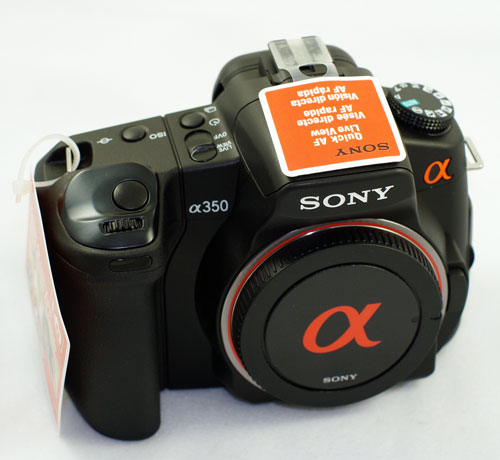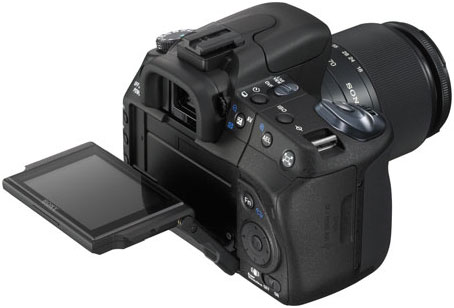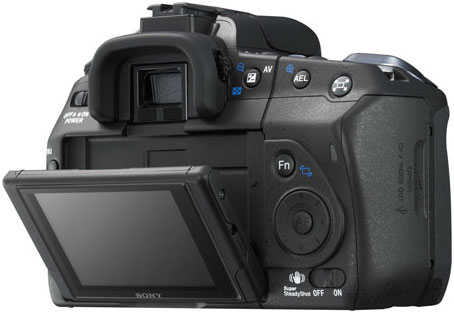Sony A350: Full-Time Live View at 14.2MP
by Wesley Fink on April 3, 2008 3:00 AM EST- Posted in
- Digital Camera
Features and Handling
Sony is used to playing in the large volume retail space where every trick used to gain visibility can result in higher sales.

This is very clear in the packaging theme for Sony DSLR cameras and accessories. No one will miss the bright orange and white (or bright orange and silver) that makes the Sony packages stand out.

The A350 body is on the small side, like the other Sony entry DSLR models, without the extreme smallness that seems to some a problem with the Canon XTi or Nikon D60/D40x. The new Canon XSi is a bit larger than the previous model to address size complaints and accommodate a 3.0" LCD. The Sony A350 is both a little wider (5.25" vs. 5.1") and taller (4.0" vs. 3.8") than the upsized XSi. Minolta pioneered body-integral image stabilization, and the evolved Sony Super Steady Shot is a feature on every Sony DSLR, along with auto sensor cleaning.
The top deck contains a single dial to adjust mode (full-auto, program, shutter-priority, and aperture-priority) and a wide selection of special scene programs such as portrait, sports, night, etc. On the opposite side of the viewfinder hump you will find a mechanical (no power required) Live View/OVF (Optical Viewfinder) switch, timer/drive mode button, and ISO button. The shutter release and shift/adjust dial are on top of the comfortable handgrip.

9-point auto-focus is featured on the A350. The layout and pattern is the same as the A200, A300, and earlier A100 suggesting it is the same AF module. The burst AF speeds on all models also support the conclusion that this is likely the same venerable AF module used in previous Minolta and Sony digital SLRs. Sony claims faster AF in the newest models, and that is likely the result of faster data processing in the supporting data processing modules in the DSLR. The prosumer A700 uses an updated and faster 11-point AF system. The A350 AF system is very competitive in its class and a big step up from the Olympus 510/410/420 and Nikon D60/D40x 3-point AF modules.


While the A350 is a bit larger than the Canon XSi, the LCD is 2.7" instead of the 3.0" LCD featured on the XSi. However, it is the only LCD in its class that is articulated, allowing an upward tilt as far as perpendicular for low-level shots and a down tilt to allow holding the camera above your head for crowd shots. These kinds of shooting situations require a contortionist on the usual DSLR and they are a great benefit for the capable and fast Sony Quick AF Live View. The LCD brightness is adjustable up and down, but it was still a challenge to read info on the LCD in bright sunlight. Perhaps some aftermarket LCD hood will improve LCD viewing.

The rear finds the on-off switch to the left of the viewfinder, which is typical of all the current Sony models. To the right of the viewfinder are the metering pattern/exposure compensation button, AEL (exposure lock)/zoom button, and the unique auto teleconverter. The teleconverter switch just takes advantage of the high-resolution sensor to give you instant 1.4x and 2x crops of the regular image. It does not add or interpolate pixels.
The main part of the a350's back is dominated by the 2.7" tilt screen, and the expected MENU, DISPlay, Delete (Trash Can), and Playback buttons to the left of the screen. To the right is the extremely useful Fn (function) button, which brings up the most commonly used adjustments to allow quick adjustments without searching through menus. The up/down/select multi-controller is used to navigate menus and the screen and a Super Steady Shot on/off switch complete the rear controls.
The sensors at the bottom of the viewfinder are the trademark Minolta "auto-on" when you bring the viewfinder toward your face in OVF mode. There is also a small knurled wheel to adjust viewfinder focus to match your eyesight. This former high-end feature is now making its way into almost all of today's DSLR cameras.
Handling
The A350 is an entry-level camera despite some high-end features like the 14.2MP sensor. As such, it is designed to be easy to use. Ours came out of the package setup at the factory for Live View mode with Super Steady Shot on. In general, Sony made the controls very easy to use and figure out. Sony tells us one complaint from buyers moving from point-and-shoot digital cameras to a digital SLR is that they are often overwhelmed by the controls of the DSLR. Point-and-Shoot users will find the A350 easy to use and familiar right out of the box.
Another editor at AnandTech ordered the A350 from SonyStyle as soon as he saw the specifications in our PMA reporting. He received his A350 last week and commented that the controls on the A350 were extremely easy to figure out and use. He said after 15 minutes he felt like he could figure out most everything on the camera and he was ready to "shoot like a Pro" with the A350. If other new users also find this kind of "instant comfort" with the A350, it will become a big seller.










113 Comments
View All Comments
haplo602 - Friday, April 4, 2008 - link
Well done on the reshot. The only one lacking is the Canon 5D (should be the same image area) but other than that, quite fine.I read through almost all the comment pages and I have a few things to add.
AT is a page for geeks and enthusiasts that want the best tool for the job. In this case mostly a gaming rig (AT still has gaps in OS, server, workstation reviews). I noticed that you do not want to mimic the other established sites. The problem is, there is not much choice.
The camera models differ in details that are largely unimportant to the usual AT visitor. And you cannot expect people to ditch an SRL system when they got more than just body+kit lense.
So I suggest you pick a place that covers what the average AT visitor wants to know - make a POLL/survey about that.
Pixel peeping is not for normal people. They shoot at max ISO 800 (or whatever the auto iso setting will max at). Mostly leave the photos in digital form to present on web galleries. Hardly anybody does larger prints (beyond 10x15 cm photo). BUT I think they are concerned about ease of use, good camera manual, availability of accessories (lenses, flashes etc.), performance in mostly auto or program mode, JPEG quality and such.
These are the areas AT should work on. Hardly any serious photo site does review the automated or (idiot) scene modes.
Truth is, whoever does use scene modes on an SLR shoudl be still using a point and shoot, but there is a group of people that are not satisfied with the limits of P&S cameras, yet they have not mastered the science behind photography. These will be interested in the areas I just mentioned.
I'd say give it a thought, do a review based on that and see the reactions ...
Wesley Fink - Friday, April 4, 2008 - link
Since I have had several requests for same "field of view" images and crops for the Canon 5D I have added a page 7 with two sets of Canon 5D crops and full images.One set is taken from the same location with the 50mm lens. That is the set that was already in the updated review an it provides a greater field of view on the 5D than on the 1.5X multiplier cameras.
The second set of 5D images were shot with the same camera and 50mm lens moved closer to the image to try to maintain the same field of view. Despite the different fields of view, all Canon 5D cropped images are still maintained at 230x300 pixels.
With both sets of Canon 5D images you should be able to compare the A350 and Canon 5D images as you would like to see them compared.
danddon - Friday, April 4, 2008 - link
Thank you for correcting this issue. These crops are better, but not the areas are still identical in size. Perhaps you can improve in your next set.Now, then - how about some comments on photosite size discrepancies between the a350 and 5D? Since the 5D has a larger sensor, with a smaller number of pixels, the photosites are correspondingly larger. Hence, for any given light level, these photosites will gather more photons than the a350. This will result in a higher signal to noise ratio, with less noise appearing in the crop.
Since you are fond of not getting too technical, let's say the photosites are twice as large in the 5D. If so, then should we not be comparing, say, the iso3200 on the 5D with the iso1600 on the a350?
If you do not like the above numbers, please give us unwashed readers your take on how to account for these differences in sensor sizes. Surely, you want to provide this analysis. Yes?
Wesley Fink - Friday, April 4, 2008 - link
Since we are still dealing with different sensor resolutions, the same field of view will yield slightly different crops since we are maintaining the same pixel crop size of 230x300. The Canon 5D is 12.2 megapixels and the Sony is 14.2 megapixels. So a same-size crop from an equivalent field of view image on the Canon 5D would still show more area than the same pixel-size crop from the higher resolution A350. To produce same pixel-size crops and take this into account would take endless manipulation with each camera tested that had a different sensor resolution or multiplier.The Pentax K20D at 14.6 and the Sony at 14.2 are closer in resolution so the differences are not as great, but there are still differences in the same pixel crops. As we would expect the Sony crop view is a bit wider since it is a bit lower in resolution than the Pentax.
We could just crop the same area from equivalent field of view photos, as I have seen done in some other photo reviews. However, it is my opinion that is not a fair representation of noise since the crop areas would represent different total pixels. This becomes an interesting problem when you compare a 10 megapixel sensor since the resolution is almost 50% less than the Pentax K20D.
danddon - Friday, April 4, 2008 - link
How about the issue of photosite size?From “Digital Photography Review”:
Canon 5D
Sensor Size = 35.8mm x 23.9 mm
Max Image = 4368 x 2912 pixels
Alpha 350
Sensor Size = 23.6mm x 15.8 mm
Max Image = 4592 x 3056 pixels
Assuming the above numbers are in the ballpark, we get a photosite maximum possible size of:
5D = 35.8/4368 = 8.196 or 8 microns
23.9/2912 = 8.207 or 8 microns
a350 = 23.6/4592 = 5.139 or 5 microns
15.8/3056 = 5.170 or 5 microns
Thus the 5D has a photosite area of 8x8 or 64 sq. microns
Likewise, the a350 has an area of 5x5 or 25 sq. microns
If we ignore the reductions in these areas due to photosite boundaries, which would be required for light shielding between sites and for electronics, then we can say that the 5D has approximately 2.5 times more photosite area than the a350.
Thus, everything else being equal and for the same iso setting, the 5D will gather 2.5 times more photons than the a350, with a correspondingly better signal to noise ratio, and less visible noise in the resulting image.
Therefore, why should one compare iso3200 on the a350 with iso3200 on the 5D, when the 5d would receive 2.5 times more photons in each photosite? Please explain.
Wesley Fink - Friday, April 4, 2008 - link
First of all the photosite size for the K20D does not scale as you indicate. One of the Samsung/Pentax big deals is that they say they have reduced the space between photosites to increase the size. They claim the 14.6 megapixel sensor has about the same size photosites as the Sony A700/Canon A300 12.2 megapixel sensor.All else being equal the photosite size obviously matters, but all else is never equal. You can can compare the photos and crops for yourself in this review instead of calculating what should and should not be compared. As I have learned in reviewing computer components, assumptions and suppositions often get you in trouble.
danddon - Friday, April 4, 2008 - link
Then how does it scale? How about some math instead of words?And who even mentioned the K20D? The comparison being discussed is between the a350 and the 5D. Can you read?
LOL ...
I have heard enough. And, it was far too little to be of any value. Thanks, anyway.
danddon - Friday, April 4, 2008 - link
This sentence:"These crops are better, but not the areas are still identical in size."
should read:
"These crops are better, but not the image areas are still not identical in size."
Sorry for the confusion. My bad.
danddon - Friday, April 4, 2008 - link
This sentence:"These crops are better, but not the areas are still identical in size."
should read:
"These crops are better, but the image areas are still not identical in size."
Sorry for the confusion. My bad - 2.
Maxington - Friday, April 4, 2008 - link
Just keep improving your reviews and listening to constructive comments Wesley. I appreciate a different take on reviews regardless, you always have to read multiple reviews from multiple people to get a proper take on a product. All of them cover a different aspect that the others didn't take into account.There is no perfect way to review cameras, have you seen the DPReview forums? They are pretty much the gold standard for reviews, and after every review, there are dozens of threads decrying the obvious flaws in the testing system! You can't win again people who are far more interested in measurebating the tech specs than taking photos, and there is no way to remove all variances between different cameras, let alone entire brands.
I tend to feel there is a lot less bias in your reviews than most "camera" sites. A lot of those smack of "If its not Canon/Nikon, its not a camera".
Hell, most of the issues that the measurebater crowd are niggling at won't even be visible in real life photos.